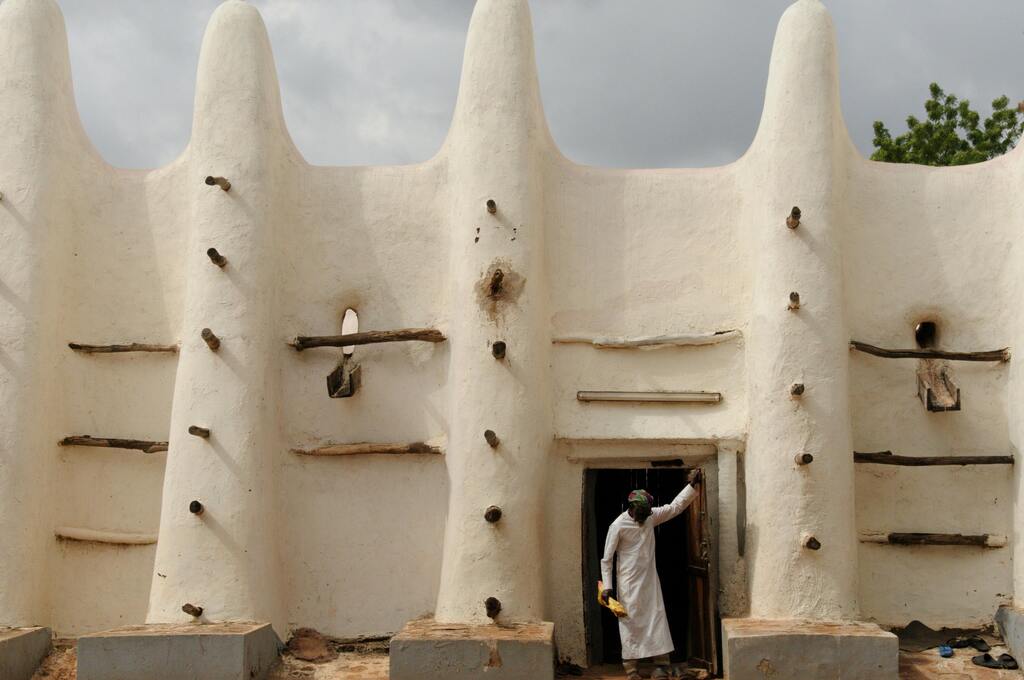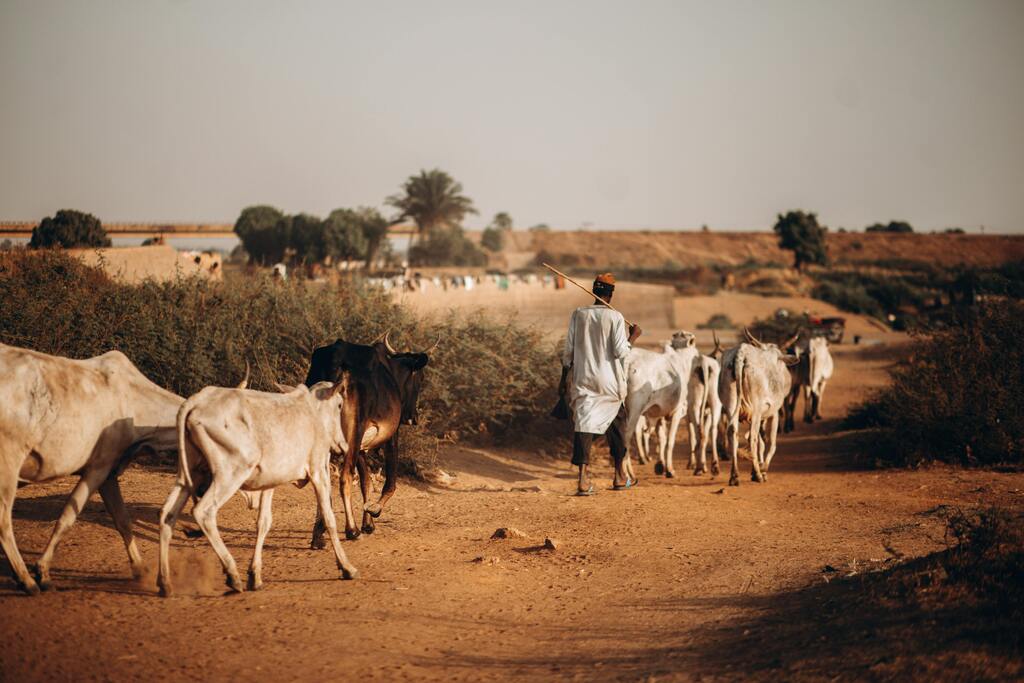The White Mosque of the Savannah: The Sacred Mud Mosque of Northern Ghana
English (for reference)
"Larabanga Mosque is one of West Africa’s oldest mosques. Built in 1421 by Ayuba after a divine vision, this mud‑and‑stick mosque stands as a sacred center of faith and tradition in northern Ghana."
Gonja (Ngbanya)
“Larabanga La Musjid yɛ West Africa la yima La musjid. Ayuba kan 1421 la bɔ, na se yɛ Nkwagyeɛ fong, ni ye bi Tatɔ Musjid yili ho. N malu wuli laa, yɛ dindi ni yel ka.”
Dagbani
“Larabanga Ʒim dɔɣu Allah nɛ zuŋ nisɔɣi niya. Ayuba yɔbɔ 1421, laa ŋdi kure yuli ni yɛli n-onim, ni tuma zuɣu gɔŋbu. Nɛ yɛ singa mɔɣɔ lɛ n-yam.”
In the dusty northern savannah of Ghana, in the quiet town of Larabanga, stands one of West Africa’s oldest and most revered Islamic structures: the Larabanga Mosque.
In the heart of Ghana’s northern savannah, where red earth meets open sky, stands one of West Africa’s most spiritually revered and historically significant Islamic structures — the Larabanga Mosque. With its whitewashed mud walls, ancient wooden beams, and centuries-old legacy, the mosque is not merely an architectural relic but a living center of faith and cultural memory. Revered by Muslims across the region and admired by historians around the world, Larabanga is not just Ghana’s oldest mosque — it is one of the oldest mosques in all of West Africa, believed to have been founded as early as 1421.
The origin of the mosque is deeply rooted in oral tradition, passed down by local elders for generations. According to legend, a Malian Muslim mystic named Ayuba — sometimes also referred to as Yahya — was traveling through what is now the Savanna Region when he stopped to pray near the present-day town of Larabanga. That night, he had a vision directing him to build a mosque where his spear would land. When he awoke the next morning, the foundation of the mosque had miraculously appeared at that exact spot. Taking this as a divine sign, he remained in Larabanga, where the mosque was eventually constructed and became a permanent center of Islamic worship and learning.

Larabanga Mosque - Please, be respectful!
Local legend attributes the mosque’s founding to a Malian trader and Islamic mystic named Ayuba, or “Yahya.” According to the oral accounts of Larabanga’s elders, Ayuba was passing through the area on a pilgrimage (some say to Mecca) when he received a divine vision instructing him to settle in the area and build a mosque.
While there are no early written records to confirm the story, the oral account aligns with historical patterns of Islamic expansion in West Africa. The region was part of a broad corridor through which Islam spread peacefully over centuries, brought by traders, scholars, and spiritual teachers along trans-Saharan routes that linked major cities like Timbuktu and Gao with the savannah towns of what is now northern Ghana. Islam came not as a colonial force, but as part of an interconnected world of learning, pilgrimage, trade, and diplomacy.
The architecture of the Larabanga Mosque reflects this trans-Sahelian connection. Constructed in the Sudano-Sahelian style, the mosque is made entirely of mud and timber, designed to adapt to the local climate while embodying Islamic artistic forms. Its thick, earthen walls help regulate interior temperature, while the projecting wooden beams — called toron — serve both as decoration and as built-in scaffolding for regular maintenance. Two towers rise from the structure: a rounded minaret and a mihrab tower that marks the direction of Mecca.
The dimensions of the mosque are approximately 8 meters by 8 meters, modest in size but monumental in meaning. Its presence is unmistakable in the landscape — painted in contrasting white and black, its silhouette has remained unchanged for centuries. Inside, the mosque has separate spaces for men and women, a central prayer hall, and a small enclosure where a handwritten Qur’an, believed to be of ancient origin, is kept under the protection of local imams.
Today, the Larabanga Mosque remains a functioning place of worship, a center for community gatherings, and a destination for pilgrims and tourists alike. Despite its age, it is maintained not by preservationists alone, but by the local community, who continue the tradition of annual mud replastering known as gbalahi. This ceremony is both practical and spiritual — a form of prayer through labor, binding the people of Larabanga to their history and to each other.
The mosque is located in a predominantly Muslim region. Most communities in the northern parts of Ghana — particularly the Northern Region and the Savanna Region — practice Islam, and the mosque has long been a spiritual anchor for the faithful. In Larabanga and the surrounding towns, the mosque is not viewed as a museum piece, but as a sacred, living space — a testament to centuries of devotion and cultural continuity.
In recognition of its cultural value and vulnerability, the mosque was once listed among the World Monuments Fund’s 100 Most Endangered Sites. Although modern preservation efforts have helped stabilize the structure, its true strength lies in the hands of those who maintain it year after year with the same materials and care used by their ancestors.
For those wishing to visit the Larabanga Mosque, it is open to the public, though non-Muslims are asked to respect local customs and may be restricted to observing from the outside or designated areas unless accompanied by a guide. Visitors are welcomed warmly but are expected to dress modestly and conduct themselves with reverence, as the mosque remains an active religious site.
Opening Times:
The mosque can be visited daily between 7:00 AM and 6:00 PM, though Friday prayers and religious holidays may affect access. Early morning and late afternoon are ideal for photography and for experiencing the peaceful atmosphere of the village.
How to Get There:
Larabanga is located approximately 10 miles (16 km) west of Damongo, the district capital of West Gonja, and only about 5 miles from the entrance to Mole National Park — making it a popular cultural stop for travelers heading to the park. Damongo is about 72 miles west of Tamale, the regional capital, which has the nearest airport and major bus connections. From Tamale, Larabanga can be reached via private car, taxi, or local minibus. Signage in the area is limited, so local guidance is recommended for first-time visitors.
And as you are there, already...Larabang is a gate to Mole National Park!
For many who come, a visit to the Larabanga Mosque is more than a historical excursion — it is a journey into a part of Ghana’s past that predates European contact and continues to shape its spiritual present. The mosque stands as a quiet, powerful reminder that faith, memory, and earth can come together to create something lasting — something worthy of reverence, protection, and pride.

Savannah area. Most of the year, a dry land.